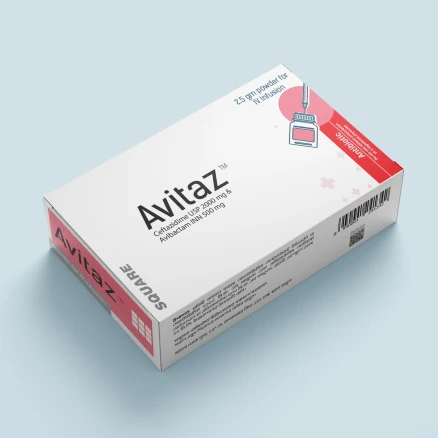
Avitaz (2 gm+0.5 gm)/vial
IV Infusion
Ceftazidime + AvibactamSquare Pharmaceuticals PLC
MRP ৳ 2800 10% Off
Best Price:৳ 2520/Piece
Medicine Overview
Indications
Avitaz IV Infusion is indicated in-
- Complicated Intra-abdominal Infections (cIAI)
- Complicated Urinary Tract Infections (cUTI), including Pyelonephritis
- Hospital-acquired Bacterial Pneumonia and Ventilator-associated Bacterial Pneumonia (HABP/VABP)
Pharmacology
Ceftazidime inhibits bacterial peptidoglycan cell wall synthesis following binding to penicillin binding proteins (PBPs), which leads to bacterial cell lysis and death. Avibactam is a non β-lactam, β-lactamase inhibitor that acts by forming a covalent adduct with the enzyme that is stable to hydrolysis. It inhibits both Ambler class A and class C β-lactamases and some class D enzymes, including extended-spectrum β-lactamases (ESBLs), KPC and OXA-48 carbapenemases, and AmpC enzymes. Avibactam does not inhibit class B enzymes (metallo-β-lactamases) and is not able to inhibit many class D enzymes.
Dosage & Administration
Dosage in Adult Patients with Creatinine Clearance (CrCl) greater than 50 mL/min-
Dosage in Adult Patients with Creatinine Clearance (CrCl) less than 50 mL/min-
Dosage in Patients 3 months to < 18 years
In Pediatric Patients 2 to < 18 years with Renal Impairment-
| Infection | Dose | Frequency | Infusion Time | Duration of Treatment |
| Complicated Intra-abdominalnInfections [used in combination with metronidazole] (cIAI) | 2.5 grams | Every 8 hours | 2 hours | cIAI: 5 to 14 days cUTI: 7 to 14 days HABP/VABP: 7 to 14 days |
| Complicated Urinary Tract Infections including Pyelonephritis (cUTI) | ||||
| Hospital-acquired Bacterial Pneumonia and Ventilator- associated Bacterial Pneumonia (HABP/VABP) |
Dosage in Adult Patients with Creatinine Clearance (CrCl) less than 50 mL/min-
| Estimated CrCl (mL/minute) | Dose | Frequency |
| 31 to 50 | 1.25 grams (ceftazidime 1 gram and avibactam 0.25 grams) intravenously | Every 8 hours |
| 16 to 30 | 0.94 grams (ceftazidime 0.75 grams and avibactam 0.19 grams) intravenously | Every 12 hours |
| 6 to 15 | 0.94 grams (ceftazidime 0.75 grams and avibactam 0.19 grams) intravenously | Every 24 hours |
| Less than or equal to 5 | 0.94 grams (ceftazidime 0.75 grams and avibactam 0.19 grams) intravenously | Every 48 hours |
Dosage in Patients 3 months to < 18 years
| Infection | Age Range | Dose | Frequency | Infusion Time | Duration of Treatment |
| cIAI and cUTI including Pyelonephritis | 2 years to less than18 years | 62.5 mg/kg to a maximum of 2.5 grams (Ceftazidime 50 mg/kg and avibactam 12.5 mg/kg to a maximum dose of ceftazidime 2 grams and avibactam 0.5 grams) | Every 8 hours | 2 Hours | cIAI: 5 to 14 days cUTI: 7 to14 days |
| 6 months to less than 2 years | 62.5 mg/kg (Ceftazidime 50 mg/kg and avibactam 12.5 mg/kg) | ||||
| 3 months to less than 6 months | 50 mg/kg (Ceftazidime 40 mg/kg and avibactam 10 mg/kg) |
In Pediatric Patients 2 to < 18 years with Renal Impairment-
| Estimated eGFR (mL/min/1.73m2) | Dose | Frequency |
| 31 to 50 | 31.25 mg/kg to a maximum of 1.25 grams (Ceftazidime 25 mg/kg and avibactam 6.25 mg/kg to a maximum dose of ceftazidime 1 gram and avibactam 0.25 grams | Every 8 hours |
| 16 to 30 | 23.75 mg/kg to a maximum of 0.94 grams (Ceftazidime 19 mg/kg and avibactam 4.75 mg/kg to a maximum dose of ceftazidime 0.75 grams and avibactam 0.19 grams | Every 12 hours |
| 6 to 15 | 23.75 mg/kg to a maximum of 0.94 grams (Ceftazidime 19 mg/kg and avibactam 4.75 mg/kg to a maximum dose of ceftazidime 0.75 grams and avibactam 0.19 grams) | Every 24 hours |
| Less than or equal to 5 | 23.75 mg/kg to a maximum of 0.94 grams (Ceftazidime 19 mg/kg and avibactam 4.75 mg/kg to a maximum dose of ceftazidime 0.75 grams and avibactam 0.19 grams) | Every 48 hours |
Interaction
Clinical interaction study of this IV infusion or avibactam alone with probenecid has not been conducted, co-administration of this IV infusion with probenecid is not recommended.
Contraindications
This is contraindicated in patients with known serious hypersensitivity to the components of (ceftazidime and avibactam), avibactam-containing products or other members of the cephalosporin class.
Side Effects
Adult cIAI, cUTI and HABP/VABP Patients: The most common adverse reactions in cIAI (≥ 5%, when used with metronidazole) patients are diarrhea, nausea and vomiting. The most common adverse reactions (3%) in cUTI patients are diarrhea and nausea. The most common adverse reactions (≥5%) in HABP/VABP patients were diarrhea and vomiting. Pediatric cIAI and cUTI Patients: The most common adverse reactions (>3%) in pediatric patients were vomiting, diarrhea, rash, and infusion site phlebitis
Pregnancy & Lactation
There are no adequate and well-controlled studies of this IV infusion, ceftazidime, or avibactam in pregnant women. No information is available on the effects of ceftazidime and avibactam on the breast-fed child or on milk production.
Precautions & Warnings
Decreased efficacy in adult cIAI patients with baseline CrCl of 30 to less than or equal to 50 mL/ min: Monitor CrCl at least daily in adult and pediatric patients with changing renal function and adjust the dose of this IV infusion accordingly.
Hypersensitivity reactions: Includes anaphylaxis and serious skin reactions. Cross-hypersensitivity may occur in patients with a history of penicillin allergy. If an allergic reaction occurs, discontinue this IV infusion.
Clostridium difficile-associated diarrhea (CDAD): CDAD has been reported with nearly all systemic antibacterial agents, including this IV infusion. Evaluate if diarrhea occurs.
Central Nervous System Reactions: Seizures and other neurologic events may occur, especially in patients with renal impairment. Adjust dose in patients with renal impairment.
Hypersensitivity reactions: Includes anaphylaxis and serious skin reactions. Cross-hypersensitivity may occur in patients with a history of penicillin allergy. If an allergic reaction occurs, discontinue this IV infusion.
Clostridium difficile-associated diarrhea (CDAD): CDAD has been reported with nearly all systemic antibacterial agents, including this IV infusion. Evaluate if diarrhea occurs.
Central Nervous System Reactions: Seizures and other neurologic events may occur, especially in patients with renal impairment. Adjust dose in patients with renal impairment.
Storage Conditions
Store at temperature not exceeding 25°C in a dry place. Protect from light & moisture.

 OTC Medicine
OTC Medicine
 Prescription Medicine
Prescription Medicine
 Baby Care
Baby Care
 Women's Choice
Women's Choice
 Diabetic Care
Diabetic Care
 Dental Care
Dental Care
 Supplement
Supplement
 Personal Care
Personal Care
 Sexual Wellness
Sexual Wellness
 Devices
Devices
